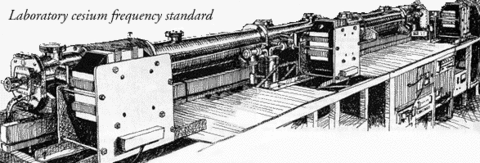A Walk Through Time - The "Atomic Age" of Time Standards
Scientists had long realized that atoms (and molecules) have resonances; each chemical element and compound absorbs and emits electromagnetic radiation at its own characteristic frequencies. These resonances are inherently stable over time and space. An atom of hydrogen or cesium here today is (so far as we know) exactly like one a million years ago or in another galaxy. Thus atoms constitute a potential "pendulum" with a reproducible rate that can form the basis for more accurate clocks.
The development of radar and extremely high frequency radio communications in the 1930s and 1940s made possible the generation of the kind of electromagnetic waves (microwaves) needed to interact with atoms. Research aimed at developing an atomic clock focused first on microwave resonances in the ammonia molecule. In 1949, NIST built the first atomic clock, which was based on ammonia. However, its performance wasn't much better than the existing standards, and attention shifted almost immediately to more promising atomic-beam devices based on cesium.

The cesium atom's natural frequency was formally recognized as the new international unit of time in 1967: the second was defined as exactly 9,192,631,770 oscillations or cycles of the cesium atom's resonant frequency, replacing the old second that was defined in terms of the Earth's motions. The second quickly became the physical quantity most accurately measured by scientists. As of January, 2002, NIST's latest primary cesium standard was capable of keeping time to about 30 billionths of a second per year. Called NIST-F1, it is the 8th of a series of cesium clocks built by NIST and NIST's first to operate on the "fountain" principle.
Other kinds of atomic clocks have also been developed for various applications; those based on hydrogen offer exceptional stability, for example, and those based on microwave absorption in rubidium vapor are more compact, lower in cost, and require less power.
Much of modern life has come to depend on precise time. The day is long past when we could get by with a timepiece accurate to the nearest quarter-hour. Transportation, communication, financial transactions, manufacturing, electric power and many other technologies have become dependent on accurate clocks. Scientific research and the demands of modern technology continue to drive our search for ever more accurate clocks. The next generation of time standards is presently under development at NIST, USNO, in France, in Germany, and other laboratories around the world.
As we continue our "Walk Through Time," we will see how agencies such as the National Institute of Standards and Technology, the U.S. Naval Observatory, and the International Bureau of Weights and Measures in Paris assist the world in maintaining a single, uniform time system.
Notice of Online Archive: This page is no longer being updated and remains online for informational and historical purposes only. The information is accurate as of 2004. For questions about page contents, please pml-webmaster [at] nist.gov (subject: A%20Walk%20Through%20Time) (contact us).

